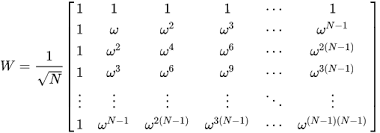DFT matrix is an expression of a discrete Fourier transform as a transformation matrix, which can be applied to a signal through matrix multiplication.
The DFT is (or can be, through appropriate selection of scaling) a unitary transform, i.e., one that preserves energy. The appropriate choice of scaling to achieve unitarity is {\displaystyle 1/{\sqrt {N}}}
How do you write a Fourier matrix?
The frequencies go in the rows of the matrix. All entries will be fill with complex exponentials e-i2*pi*k*n/N. For convenience, we write e-i2*pi*k*n/N = Wk*n. Then, the Fourier matrix can simply denotes: the Wk*n matrix.
How do you solve DFT?
- Verify Parseval’s theorem of the sequence x(n)=1n4u(n)
- Calculating, X(ejω). X∗(ejω)
- 12π∫π−π11.0625−0.5cosωdω=16/15.
- Compute the N-point DFT of x(n)=3δ(n)
- =3δ(0)×e0=1.
- Compute the N-point DFT of x(n)=7(n−n0)
Why DFT Matrix is used?
The discrete Fourier transform (DFT) is one of the most important tools in digital signal processing. For example, human speech and hearing use signals with this type of encoding. Second, the DFT can find a system’s frequency response from the system’s impulse response, and vice versa.
How do you calculate 2D DFT?
Length=P Length=Q Length=P+Q-1 For the convolution property to hold, M must be greater than or equal to P+Q-1. As in the 1D case, 2D-DFT, though a self-consistent transform, can be consider as a mean of calculating the transform of a 2D sampled signal defined over a discrete grid.
What are the applications of DSP?
DSP applications include audio and speech processing, sonar, radar and other sensor array processing, spectral density estimation, statistical signal processing, digital image processing, data compression, video coding, audio coding, image compression, signal processing for telecommunications, control systems.
What is twiddle factor in DFT?
A twiddle factor, in fast Fourier transform (FFT) algorithms, is any of the trigonometric constant coefficients that are multiply by the data in the course of the algorithm. This remains the term’s most common meaning, but it may also be used for any data-independent multiplicative constant in an FFT.
How do you calculate twiddle factor?
Twiddle factors (represented with the letter W) are a set of values that is use to speed up DFT and IDFT calculations. For a discrete sequence x(n), we can calculate its Discrete Fourier Transform and Inverse Discrete Fourier Transform using the following equations.
Use of DSP processors ?
DSPs are fabricate on MOS integrated circuit chips. They are widely use in audio signal processing, telecommunications, digital image processing, radar, sonar and speech recognition systems, and in common consumer electronic devices such as mobile phones, disk drives and high-definition television (HDTV) products.
What is the output of DFT?
The DFT is invertible, so for every unique time-domain input sequence, there should a unique DFT output. Because a real number has only one dimension and a complex number has two dimensions. The 64 real samples of the input occupy a total of 64 dimensions.






